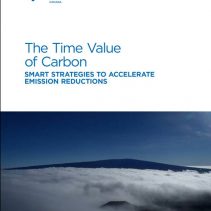The Time Value of Carbon. Stephen was the lead author of the report The Time Value of Carbon: Smart Strategies to Accelerate Emission Reductions, which was published by the Chartered Professional Accountants of Canada in 2017. The report describes the strong effects on climate change of Near-term Climate Forcers such as methane and HFCs, and explains how current greenhouse gas accounting and reporting methods underestimate these effects. For example, the current greenhouse gas reporting practice is to account for the effects on climate of all greenhouse gasses over a 100-year time horizon. The choice of 100 years is arbitrary, however, and masks the very strong near-term effects on climate of gases with much shorter lifespans. Over a 20-year time-frame, methane and refrigerant gases (HFCs) account for approximately half of the energy which all greenhouse gases contribute to global warming. The Time Value of Carbon report explains:
- Carbon emissions, like money, have a time value. Emission reductions today have a greater value than reductions postponed into the future.
- Since 1990, global carbon emissions have continued to rise, and emissions of Near-term Climate Forcers are rising more quickly than emissions of carbon dioxide.
- Reducing the risk of potentially disastrous climate change requires urgent action.
- Not all greenhouse gases affect the climate in the same way. While the total increase of temperatures over the long term is closely related to the total emissions of CO2, the rate of increase of global temperatures in the nearer term is affected by emissions of Near-term Climate Forcers.
- Reducing emissions of Near-term Climate Forcers requires different strategies than reducing CO2 emissions. Understanding this can help organizations make more focused efforts to reduce their greenhouse gas emissions.
- To understand the significance of Near-term Climate Forcers, organizations can voluntarily report their emissions based on a 20-year time horizon, a period which more closely matches the time-frame over which Near-term Climate Forcers make their greatest contributions to global warming.
The report goes on to explain how organizations can reduce emissions of Near-term Climate Forcers while simultaneously reducing costs or increasing revenues:
- Organizations can make significant and rapid contributions to addressing climate change, demonstrate leadership, and can realize the internal and external benefits of early action. Acting now will bring multiple benefits, such as: reducing the organization’s effects on climate; reducing the harm Near-term Climate Forcers cause to human health and crops; reducing risks to the organization (including the risk of increased regulatory focus on Near-term Climate Forcers); the economic value of investments to reduce emissions.
- Accounting professionals have a vital role in: helping organizations identify, quantify, and articulate the benefits of early action to address Near-term Climate Forcers; providing internal guidance on emission-reduction investments and accounting for the economic, environmental, and social benefits of early action on a life-cycle basis; highlighting the connections among external risks, costs, and benefits of early actions to address climate change, specifically with Near-term Climate Forcers.
- Accounting professionals provide insight into effective ways to mitigate risk in general. Identifying risks associated with climate change is consistent with the roles and responsibilities of professional accountants in society.
- The more all professionals understand how human activities affect climate change and how different strategies can reduce emissions, the more effective they can be in fulfilling our broadest responsibilities to society.
You can read about the background to the report here, and the English version of the report can be downloaded here.
Vous pouvez lire des informations sur l’arrière-plan du rapport en français ici, et la version française du rapport peut être téléchargée ici.


